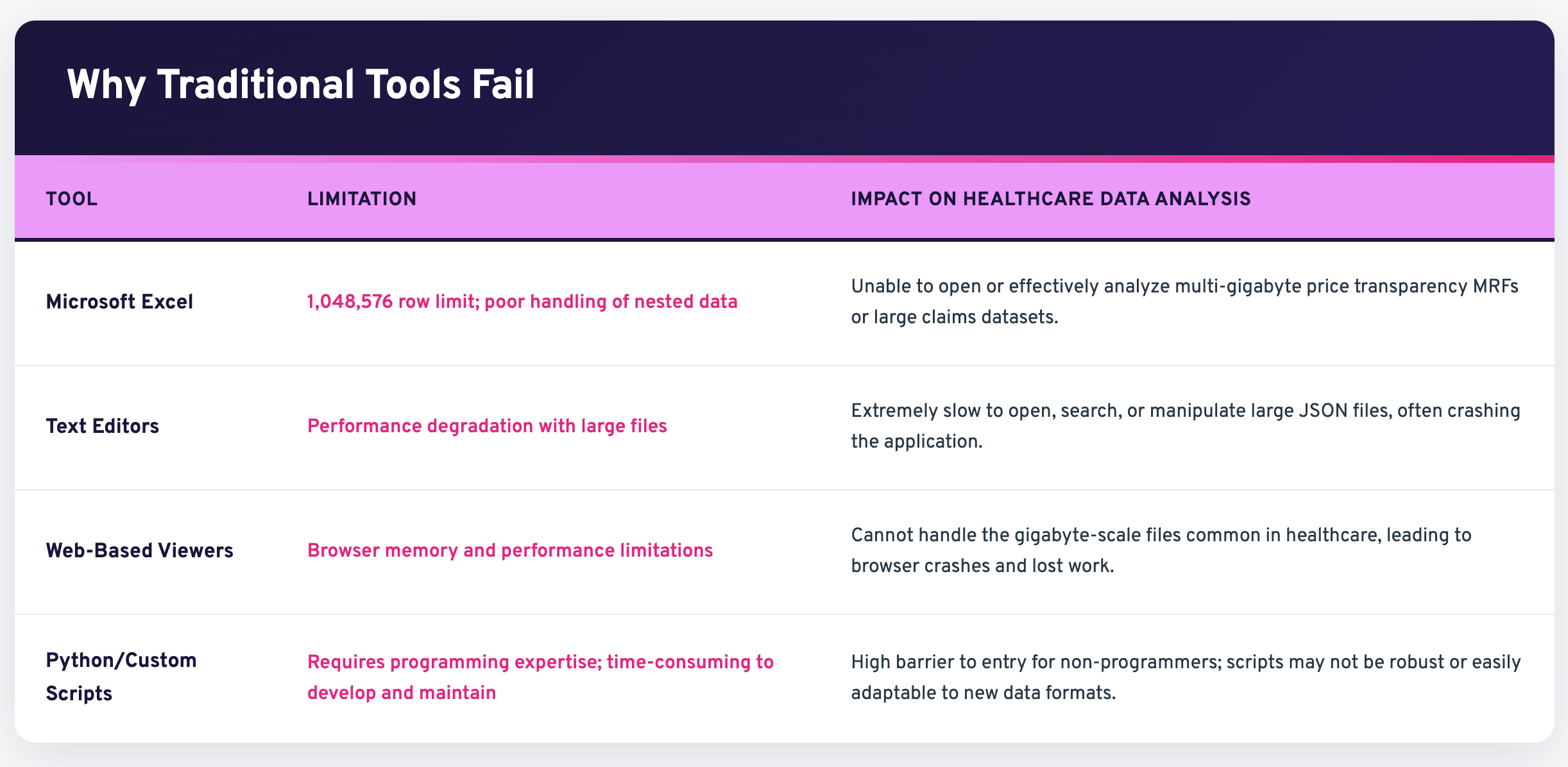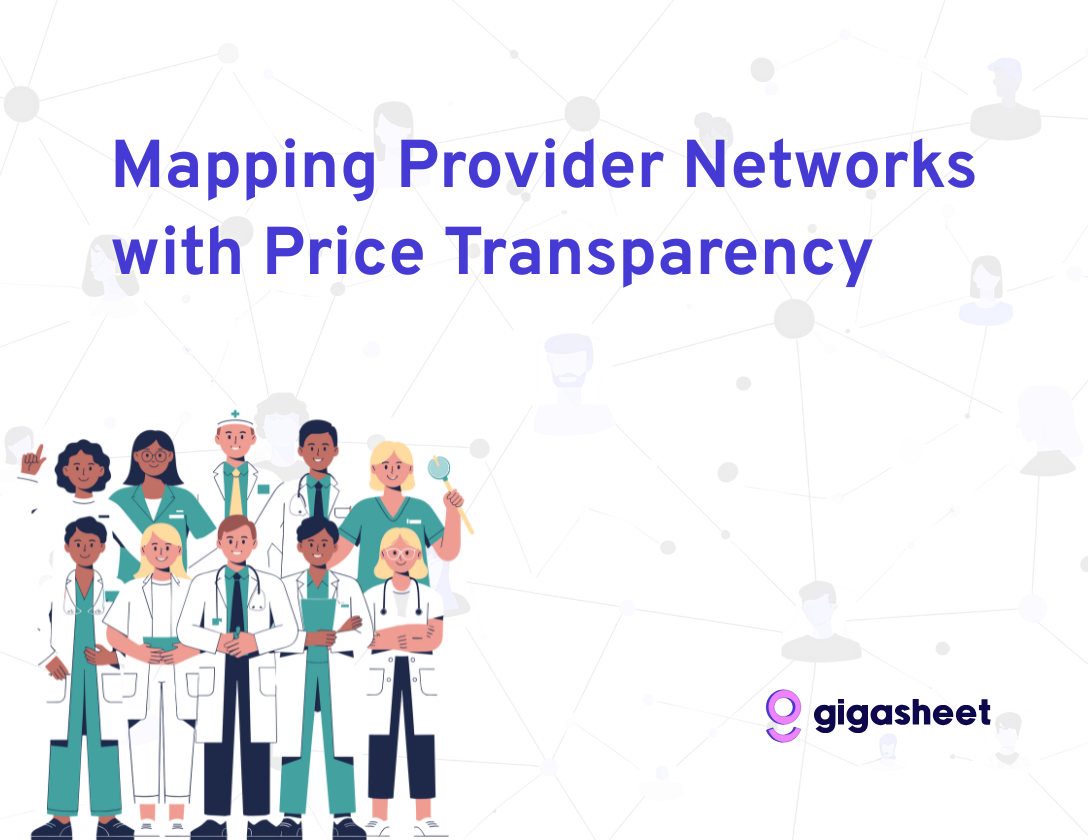Healthcare
How to Open & Analyze Large JSON Files Without Coding: A Healthcare Price Transparency Use Case
.png)
JSON has become the preferred data format across industries due to its human-readable structure and system independence, enabling applications to store complex nested datasets efficiently. While developers appreciate JSON's flexibility, many healthcare analysts and business users need to work with JSON files without extensive programming knowledge. Healthcare organizations working with large JSON datasets, especially from the Centers for Medicare & Medicaid Services (CMS) Transparency in Coverage Rule, need reliable solutions that don't require extensive technical expertise.
Healthcare analysts and business intelligence professionals often encounter significant challenges when working with large JSON datasets from claims systems, EHRs, or price transparency files. These machine-readable files (MRFs) are often massive, messy, and far from transparent, making it difficult to extract actionable insights. This article will demonstrate how to open and analyze these large, complex JSON files without writing a single line of code.
The Challenge of Large JSON Files in Healthcare
Traditionally, healthcare analysts have faced a difficult choice when confronted with large JSON files. Standard tools like Microsoft Excel, which has a hard limit of 1,048,576 rows, are simply not equipped to handle the massive, nested data structures common in healthcare datasets. Even if the file can be opened, the nested nature of JSON does not translate well to Excel's flat, row-and-column format.
For those with programming skills, writing a Python script is a common workaround. However, this approach presents its own set of challenges. Learning a programming language simply to analyze a file is a significant time investment, and building and maintaining custom scripts can be complex and error-prone. This reality often leaves analysts feeling pressured to be "unicorn analysts" who can code, manage databases, and perform data science tasks, when their real value lies in their analytical expertise.
Why Traditional Tools Fail

A Practical Example: Analyzing Hospital Price Transparency Data
Let's consider a real-world example: analyzing a large JSON file containing hospital price transparency data. This dataset, which is nearly 2GB in size and contains over 8 million records, is too large to open in Excel or a standard text editor. Each record has a complex, nested structure, with variations in the data fields.
Our goal is to answer a simple business question: which provider network appears most frequently in this payer's data?
With Gigasheet, a no-code, big data analytics platform, this task becomes straightforward. You can upload the large JSON file (even in a zipped format to save time) directly into Gigasheet. The platform automatically flattens the nested JSON structure into a familiar row-and-column format, ready for analysis.
Once the data is loaded, you can see the distinct sender and recipient addresses, which in this context represent different provider networks. To analyze the domains, we can use Gigasheet's built-in tools to split the email columns at the "@" symbol, creating new columns with just the domain names.
By combining these new columns, we can create a single, unified list of all provider network domains. A simple "Group" operation on this new column instantly reveals the frequency of each domain, answering our original question in a matter of minutes, not hours or days.
From Raw Data to Actionable Intelligence with Gigasheet
This example demonstrates how Gigasheet transforms the challenge of working with large JSON files into a simple, intuitive process. But Gigasheet is more than just a large file viewer. It is a powerful analytics workbench that transforms complex payer and hospital price transparency data into actionable insights.
Gigasheet cleans, structures, and enriches massive machine-readable files (MRFs), making analysis and comparison easy. With access to clean rates from any payer and more than 5,500 hospitals nationwide, healthcare organizations can:
•For Payers: Streamline network development, accelerate recruitment, and negotiate stronger contracts.
•For Providers: Benchmark rates against competitors, strengthen negotiation power, and uncover new revenue opportunities.
•For MedTech & Life Science: support market access & reimbursement; Support sales and identify comparable reference rates.
Our commitment to healthcare analytics excellence drives continuous innovation, ensuring our platform addresses the evolving data challenges facing healthcare payers, providers, and MedTech organizations. Healthcare analysts can focus on generating actionable insights rather than wrestling with technical data preparation challenges that traditionally required specialized programming skills.
This approach transforms how healthcare organizations handle complex JSON datasets, enabling analysts to derive meaningful insights from price transparency files, claims data, and other critical healthcare information sources with unprecedented ease and reliability.
Ready to see for yourself? Sign up for a free Gigasheet account and test out analyzing large JSON files today.
The ease of a spreadsheet. The power of price transparency.



















